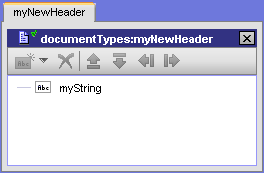messageContext | Object Message context containing the SOAP message to which to add a header element. A message context contains properties for the SOAP message and provides access to the SOAP message. Integration Server creates the message context and passes it to the header handler. All handlers invoked by a given instance of a SOAP request or SOAP response use the same message context, which enables you to use the message context to pass information among handlers. |
QName | Document Optional. Qualified name (namespace name and local name) of the header element to add. The QName document references the
pub.soap.utils:QName document type. Note: If you do not specify QName value, you must specify documentType. |
headerDocument | Document Document to add as a header element. Integration Server converts the document to an XML node and inserts it as a child element of the header element specified in QName. |
documentType | String Optional. Name of the IS document type that specifies the structure and namespaces of the document to use as a new header element. Integration Server uses the universal name assigned to the IS document type to determine the qualified name to use for the new header element. If you specify documentType, headerDocument must be a instance of this document type. Note: If you do not specify documentType, you must specify QName. |
mustUnderstand | String Optional. Sets the value of the mustUnderstand attribute for the new header element (block). The mustUnderstand attribute specifies whether recipients (the actor or role at which the header is targeted) are required to process a header entry. Recipients that cannot process a mandatory header entry must reject the message and return a SOAP fault. Set to: There is no default value. If you do not set mustUnderstand, Integration Server omits the mustUnderstand attribute from the header entry, which is equivalent to setting mustUnderstand to false. Note: In SOAP 1.2, the values of the mustUnderstand attribute changed from 0 and 1 to True and False; however, Integration Server processes both sets of values the same and performs any necessary conversions. |
actor | String Optional. Target of the header entry. The value of actor determines the value of the actor or role attribute for the header entry. The actor or role attribute specifies a URI for the recipient of a header entry. If you do not specify a value for actor, the actor or role attribute will be blank in the SOAP header. In SOAP 1.1, this indicates that the recipient is the ultimate destination of the SOAP message. In SOAP 1.2, this is equivalent to supplying that attribute with the value "http://www.w3.org/2003/05/soap-envelope/role/ultimateReceiver". Note: In SOAP 1.2, the actor attribute is named role; however, Integration Server processes both names the same and performs any necessary conversions. |
